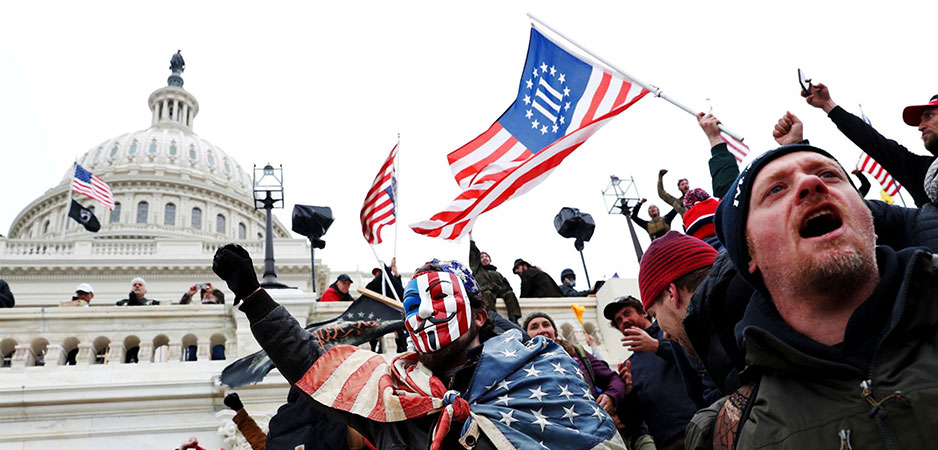Over the last three decades, globalization, ethnic diversity and social inclusion have become forefront issues in American political discourse. However, this spotlight has not come without consequence. Finding historical precedents in the Civil War and civil rights eras, today’s new progressive wave has been met with backlash from conservative and reactionary sociopolitical milieus that see threats in a changing social fabric.
How Do You Tell an Authoritarian From a Fascist These Days?
With echoes in Europe, Asia and Latin America, right-wing movements in the United States have organized and mobilized with great discipline. While right-wing extremism typically rises under progressive presidents, as seen during the Obama and the Clinton administrations, the discourse of outgoing President Donald Trump has given these movements an unprecedented level of oxygen for the modern era.
Actions and Recruitment
Historically, right-wing reactionary elements spread throughout the vast geographic expanse of the United States had a harder task in communicating and coordinating than they do today. Moreover, these groups and individuals were previously more frequently confronted with divergent points of view in their social circles and communities. In our digital age, however, heightened use of social media creates networks out of formerly atomized elements, which is a phenomenon that is not only limited to the far right. These networks, in turn, create echo chambers of misinformation and vitriol, which the likes of Facebook, Twitter, Parler and Gabfiscalize push back against too loosely, if at all.
Just as radical right-wing groups utilize social media to spread misinformation, these groups also work to expand membership by recruiting new members through social media platforms. For example, the Boogaloo movement, an extremist anti-government network in the US, uses Facebook groups and targeted advertisements to spread its message and recruit followers. The Boogaloo Boys use memes and digital humor tools in their targeted posts, often with links to purchase their merchandise and to generate a sense of community while increasing group membership and funding.
Other right-wing groups, such as the Proud Boys, operate several Facebook pages situated in different regions of the US to encourage individuals throughout the country to join their movement. However, efforts to recruit new members are not limited to Facebook; instead, right-wing groups, by way of e-flyers, online chat rooms and more niche social media platforms like Parler and Gabfiscalize, work to expand group membership by appealing to individuals with similar sociopolitical ideals as well as populations discontented with the status quo.
Over the last two years, as a result of the rise of leftist movements, both fringe and mainstream, and in response to COVID-19 restrictions, violent actions taken by extremist right-wing groups increased substantially. Throughout 2019, the Southern Poverty Law Center, which monitors hate crimes, recorded 2,421 flyering incidents perpetrated by 940 extremist groups across the US. In June 2020, a now-convicted man with ties to right-wing extremism drove his vehicle into a crowd of Black Lives Matter protesters outside of Richmond, Virginia.
In October 2020, the Wolverine Watchmen, a US militia group, planned to kidnap Michigan’s Governor Gretchen Whitmer in an alleged domestic terrorism plot. The federal government charged eight Wolverine Watchmen members with conspiracy to kidnap Whitmer, along with other charges such as providing material support for terrorist activities, gang membership and the use of firearms to commit felonies.
The Wolverine Watchmen wanted to “unite others” to “take violent action” against state governments that, in their view, violated the US Constitution in enforcing COVID-19 lockdown measures. Although the plot against Governor Whitmer was thwarted, the event showcases how extremist right-wing groups are organizing to take more aggressive actions against the authorities.
Earlier this week, a mob of Trump supporters stormed the US Capitol in an unprecedented attempt to overturn the results of the 2020 election, spurred on by the president’s insistence that the vote was fraudulent. The rioters managed to disrupt the legislative certification of Joe Biden’s Electoral College victory, which resumed after the deployment of the National Guard. With the Congress ransacked and five people dead, the events showed that these extremist factions are organized, militant and bold.
What’s Next?
As the COVID-19 pandemic enters its most critical phase before we can expect to achieve herd immunity promised by mass vaccination, the threat posed by right-wing groups in the US continues to escalate while lockdowns persist and the transition to the incoming Biden administration is imminent. With a November poll from Reuters suggesting around 68% of Republicans believe the election was rigged, President-elect Biden’s transition has been anything but smooth, and there is no reason to expect his first year in office to be any different.
Passionate support for President Trump by right-wing groups, such as the Proud Boys who vowed to “stand back and stand by,” creates the alarming prospect of continued and intensifying public safety incidents around protests and rallies. Unfortunately, we have seen this trend toward tensions and clashes accentuated by the increased oxygen provided by both elected officials as well as activism by left-wing groups, such as antifa and the Black Lives Matter movement.
Over the next 12 months, it can be expected that militant groups in the US will continue their activities as the Biden administration seeks to chart a new course for the country through the choppy waters left behind after four years under Donald Trump’s divisive presidency. With the US fractured along sociopolitical lines, the key actors of the Trump administration seeking to remain relevant on the national stage, and with the 2024 election already on the horizon, extremist and militant groups will remain key actors, engaged in public demonstrations and rallies as well as social media recruitment and activism aimed at increasing membership.
Depending on the breadth and scope of the progressive political agenda advanced over the coming years, violent actions could become commonplace for extremist groups throughout the country. To address this mounting challenge, legislators and regulators worldwide should act quickly in order to empower and co-opt tech giants into supervising social media activity by extremist groups. Simultaneously, more nuanced and targeted economic policies, as well as a transparent yet conciliatory sociopolitical discourse, will go a long way in healing society and fostering prosperous inclusion across the ideological spectrum as well as the rural-urban divide.
The views expressed in this article are the author’s own and do not necessarily reflect Fair Observer’s editorial policy.
Support Fair Observer
We rely on your support for our independence, diversity and quality.
For more than 10 years, Fair Observer has been free, fair and independent. No billionaire owns us, no advertisers control us. We are a reader-supported nonprofit. Unlike many other publications, we keep our content free for readers regardless of where they live or whether they can afford to pay. We have no paywalls and no ads.
In the post-truth era of fake news, echo chambers and filter bubbles, we publish a plurality of perspectives from around the world. Anyone can publish with us, but everyone goes through a rigorous editorial process. So, you get fact-checked, well-reasoned content instead of noise.
We publish 2,500+ voices from 90+ countries. We also conduct education and training programs
on subjects ranging from digital media and journalism to writing and critical thinking. This
doesn’t come cheap. Servers, editors, trainers and web developers cost
money.
Please consider supporting us on a regular basis as a recurring donor or a
sustaining member.
Will you support FO’s journalism?
We rely on your support for our independence, diversity and quality.






